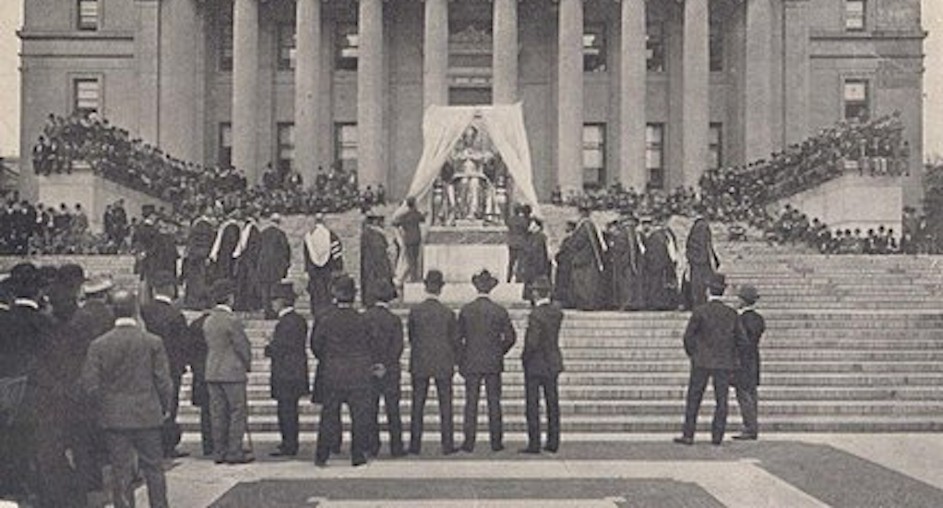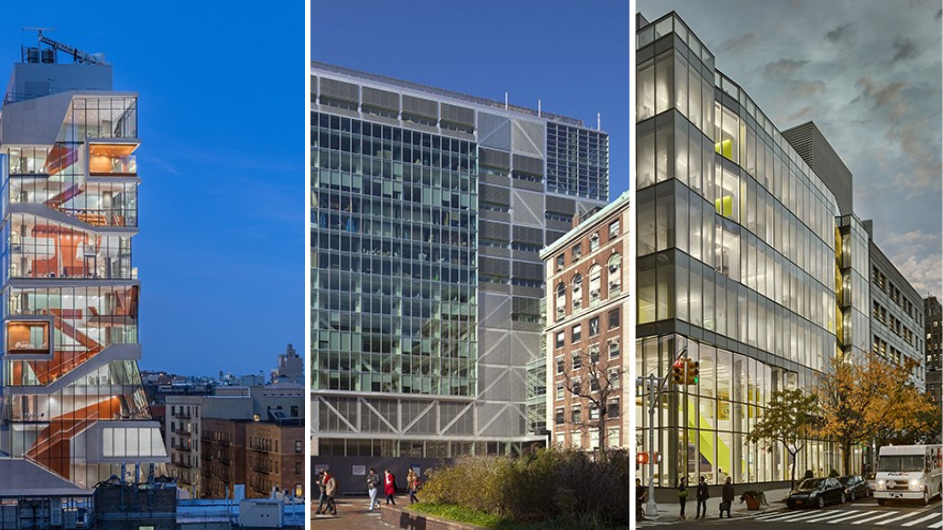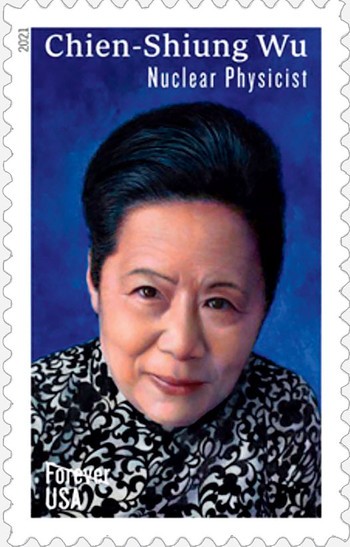Looking Out on a City and a World
Columbia University is the oldest institution of higher education in New York, and the fifth-oldest in the United States. Today, it is one of the world’s leading research institutions and has a world-renowned medical center. Columbia provides a distinctive and rigorous learning environment for undergraduate and graduate students in a variety of scholarly and professional fields.
Columbia University embodies “a spirit that does not look inward at itself, but outward on a city and a world.”
With its 17 schools and four affiliate schools spread over four campuses located in and around New York City, the University understands its regional and global impact. Indeed, as the philosopher Frederick J.E. Woodbridge, who spent more than three decades at Columbia in the early 20th century, notably said, the University is “inextricably mixed up with what is going on in the world. It is a spirit that does not look inward at itself, but outward on a city and a world.”
Historical Points of Interest
Woodbridge’s characterization of Columbia has been echoed through the generations. Lee C. Bollinger, president emeritus, harnessed the words in his 2002 inaugural address in his commitment to broadening Columbia’s global reach and fostering the University’s vital role in engaging with the great problems facing society. And President Minouche Shafik quoted Woodbridge in her initial remarks, upon her appointment in January 2023, as Columbia’s first female president. “Whether it is tackling challenges like climate change or a global public health crisis, or exploring the foundations of philosophy, science, and the arts through the Core Curriculum, Columbia thrives as a center for ideas and advancement because it is a rich, diverse community where everyone has something to contribute.”
That vital role of civic engagement has infused Columbia since its earliest days in 1754 in a schoolhouse at the lower tip of Manhattan to its current incarnation as a leading Ivy League University in New York City, with 11 global centers around the world.
A Brief Timeline of Columbia University in the City of New York
1754
Columbia was founded as the all-male King’s College in 1754, established by a royal charter issued by Great Britain’s King George II. The College’s first president, Samuel Johnson, presided over its first-ever class, which was held in a schoolhouse connected to Trinity Church in lower Manhattan.

1763
Myles Cooper, a graduate of Queen’s College, Oxford University, and an ardent supporter of the British monarchy, succeeded Johnson as president. In the lead-up to the American Revolution, the climate on campus was politically charged. Among the early King’s College students were John Jay, who became the first Chief Justice of the United States Supreme Court; Alexander Hamilton, who became the first secretary of the Treasury; Gouverneur Morris, who was later a lead author of the final draft of the U.S. Constitution; and Robert R. Livingston, who would help draft the Declaration of Independence.

1767
The medical school opened under the leadership of Samuel Bard. Three years later granted the first MD degree in the American colonies. Bard enslaved at least eight people—and almost certainly more—during the course of his life and career as an early American physician. In 1931, a century after his death, the trustees chose to name the new medical center dormitory “Bard Hall” in his honor. The name was removed in 2020 at the urging of faculty and students.
1776
The American Revolutionary War was a difficult time for King’s College. It suspended instruction in 1776 and remained closed until 1783.
1784
King’s College reopened under a new name that emphasized its connection to the American continent: Columbia College. Three years later, the College adopted a new charter, granting oversight of the institution to a private board of trustees.
1787
The board of trustees elected as the College’s third president, William Samuel Johnson, son of the first president, Samuel Johnson.
1789
United States President George Washington and Vice President John Adams attended Columbia’s commencement as a tribute to the many alumni who had participated in the American Revolutionary War.
1801
Charles H. Wharton became president of Columbia. He resigned seven months later and was replaced by Benjamin Moore.
1811
William Harris became president of the College.
1813
The College, which struggled to get back on solid footing in the aftermath of the Revolutionary War, agreed to join its medical school with the College of Physicians and Surgeons, a new school that had been established by a state-run educational authority.
1829
William Alexander Duer became president of the College.
1842
Nathaniel Fish Moore was elected Columbia’s eighth president.
1849
Charles King, a politician and newspaper publisher, was elected president of the College. His administration was marked by significant progress and expansion.

1857
The College moved from Park Place in lower Manhattan to 49th Street and Madison Avenue, in midtown Manhattan, where it remained for the next 50 years.
1858
The Law School was founded, and six years later, the School of Mines, the first mining and metallurgy school in the U.S. and the precursor to today’s Fu Foundation School of Engineering and Applied Science, was established.

1867
Columbia began participating in intercollegiate sports. A baseball team was established in 1867, followed by a football team in 1870, and a rowing team in 1873.

1877
The student newspaper, the Columbia Daily Spectator, began publication. The Spectator still publishes to this day.
1880
The Graduate School of Arts and Sciences was founded.
1881
The Graduate School of Architecture, Planning, and Preservation was founded as a department within the School of Mines, the precursor to the Engineering School.
1889
Barnard College for Women opened during the final year of Frederick A.P. Barnard’s 25-year College presidency. Barnard believed that men and women should be educated side by side and had fought unsuccessfully against trustee, faculty, and student opposition to the inclusion of women students at Columbia College. Barnard died that same year and the new, affiliated women’s college was named in his honor.
1890
Columbia College trustee and former Brooklyn mayor, Seth Low, became Columbia’s 11th president.
1891
The College of Physicians and Surgeons officially rejoined Columbia.
1892
The School of Nursing opened, along with Teachers College one year later.

1896
Eager to expand Columbia, President Low moved the College from 49th Street to its present location in Morningside Heights, about 60 blocks north. The trustees officially authorized the use of the name Columbia University. Low Library, which was built around this time, is often thought of as a symbol of the University. Today, Low, which ceased being a library in the mid-1930s, houses a number of administrative offices, including the office of the president and the provost. (Read Columbia News article “Six Secrets of Low Library.”)
1902
Nicholas Murray Butler became president of Columbia University. A Nobel laureate and one-time vice presidential candidate, Butler served as president of Columbia for more than four decades. Under his leadership, the University grew dramatically, but Butler’s antisemitism in the management of enrollment at Columbia, and his sympathy for fascism and Nazism, has led to a reevaluation of his life’s work in recent years.
1903
The bronze statue of Alma Mater that sits to this day on the steps of Low Library was unveiled. The statue was designed by the sculptor Daniel Chester French.

1910
Columbia adopted the lion as a mascot. Read Columbia News article “12 Photos That Show the Evolution of Columbia’s Lion Mascot Over the Years.”
1912
The Journalism School opened thanks to a substantial donation from the newspaper magnate Joseph Pulitzer.
1916
The Business School opened its doors. The College of Dental Medicine was also officially established as a school in this year, though its roots date back to 1852.
1917
During World War I, President Butler established the Student Army Training Corps to support the war effort. It was housed in Hartley and Livingston Halls. He also created a smaller campus-based Naval training unit.

1919
Columbia University established the Core Curriculum, a communal learning experience for undergraduate students that cultivates community-wide discourse and deliberate contemplation around seminal works, contemporary issues, and humanity’s most enduring questions.
1922
The DeLamar Institute of Public Health, which eventually grew to become the Mailman School of Public Health, was founded. Mailman is one of the oldest public health schools in the United States.
1923
Actor and political activist Paul Robeson graduated from Columbia Law School.
Also in 1923, undergraduate student Lou Gehrig hit a .403 batting average, blasted seven home runs for a season record, and struck out a record 17 batters in a single game. By the end of the season, he was playing for the New York Yankees.

1927
Jacques Barzun graduated from Columbia College. Five years later, he graduated from Columbia’s Graduate School of Arts and Sciences. A famed historian and author, he served as provost and dean of the faculties.
1928
The writer Zora Neale Hurston graduated from Barnard College, where she was the college’s first African American student. She later pursued graduate work at Columbia with renowned anthropologist Franz Boas.

1933
Virginia Apgar graduated from Columbia’s Vagelos College of Physicians and Surgeons. An American physician, obstetrical anesthesiologist and medical researcher, she is best known as the inventor of the Apgar score, a way to quickly assess the health of a newborn child immediately after birth.
1939
Columbia hosted the first televised sporting event: the fledgling NBC network filmed the baseball double-header of Columbia versus Princeton at Baker Field.
1940
The School of Social Work, whose roots extend back to 1898, became part of Columbia University. Also in 1940, Charles R. Drew received a doctor of medical science degree from Columbia’s Vagelos College of Physicians and Surgeons (then known as the College of Physicians and Surgeons). He was the first Black researcher to earn this degree in the United States. His dissertation was based on research on the properties and preservation of blood plasma. He is considered a pioneer in the creation of a blood bank.
In the lead-up to and during World War II (1939-45), Columbia faculty played a vital role in pressing the U.S. government to begin atomic energy research, and led important parts of the Manhattan Project, which resulted in the creation of the world’s first nuclear weapons. Columbia scientists involved in atomic research in this period included John R. Dunning, Enrico Fermi, II Rabi, Leo Szilard, Edward Teller, Chien-Shiung Wu, and Walter Zinn.

1942
Columbia’s Morningside Heights campus served as a training center for the Navy. It used 12 Columbia-owned buildings to house a Midshipmen’s School that trained more than 20,000 officer candidates. As in World War I, Columbia’s medical school created a hospital in Europe to minister to the wounded. Today, Columbia University has about 600 student veterans enrolled across its colleges and schools, and has built a nationally recognized model for reintegrating veterans in higher education.

1946
The School of International Affairs (later called the School of International and Public Affairs) was founded to address the need for skilled public service professionals in the U.S. and abroad.
1947
In response to soldiers returning from World War II, an evening University extension program was reorganized as an undergraduate school, and named the School of General Studies. Eventually the school grew to include students who had taken time off between high school and college. It continues to serve a diverse population of returning and nontraditional students until this day. Nevis Laboratories, which is Columbia’s primary center for the study of high-energy experimental particle and nuclear physics, was also established in 1947.
1948
Dwight D. Eisenhower became Columbia’s president. He stayed in the role until 1953, when he was elected president of the United States.

1949
Lamont-Doherty Earth Observatory—a research institution focused on global climate change, earthquakes, volcanoes, nonrenewable resources, and environmental hazards—was established in Palisades, New York. It is now one of Columbia’s four campuses and home to the Gary C. Comer Geochemistry Building, which was built in 2006.
1953
Columbia Provost Grayson Kirk was elected president.
1959
Ruth Bader Ginsburg graduated from Columbia Law School. She later became the first female tenured professor at the law school and the second woman to serve as a justice on the U.S. Supreme Court.

1965
The School of the Arts was established to train both graduate and undergraduate students. In 1970, the school began offering only graduate courses.
1966
The Student Homophile League, believed to be the first gay student organization in the U.S., was founded.
1968
Growing opposition to the Vietnam War, an increasingly vocal Civil Rights Movement, and the ongoing decline of America’s inner cities put the Morningside campus in the national spotlight in April, when more than 1,000 protesting students occupied five campus buildings. The students effectively shut down the University until they were forcibly removed by New York City police officers. These events led to the cancellation of a proposed gym in Morningside Park that had been controversial in the community, the retirement of President Kirk, and the establishment of the University Senate.

After the upheaval, Andrew W. Cordier, a former United Nations diplomat and dean of the School of International Affairs, was appointed acting president on August 23, and became president in 1969.
1970
William J. McGill became president of the University.
1980
Michael I. Sovern became president.
1983
Columbia College began to admit women, joining Barnard and several schools within the University that had admitted women for years. Also in 1983, Barack Obama, who later became 44th president of the United States, graduated from Columbia College.

1991
The Faculty of Arts and Sciences at Columbia was formally established in 1991 as an organizational framework that unified faculty across six schools. It was formed to bring together the faculty of Columbia College, the Graduate School of Arts and Sciences, the School of General Studies, the School of the Arts, the School of Professional Studies and, until 2010, the School of International and Public Affairs.
1993
George Rupp became University president. Manning Marable, professor of public affairs, history, and African-American Studies founded and directed the Institute for Research in African-American Studies, which later became the African American and African Diaspora Studies Department.
1994
A $650 million building project began. It included the renovation and construction of several buildings on the Morningside campus and at Baker Field at the northern edge of Manhattan. It also included the wiring of the Morningside campus for Internet and wireless access.
1995
To address the absence of a formal University extension program, the School of Continuing Education—now known as the School of Professional Studies—was established.
1999
Alfred Lerner Hall, a student activities center that houses the Roone Arledge Auditorium and Cinema, opened.
2002
Lee C. Bollinger became the 19th president of Columbia University and launched a sustained effort to transform and increase alumni engagement into a partnership among volunteer leaders and alumni across the University.
2003
Columbia University celebrated its 250th anniversary, beginning with Homecoming in the fall of 2003, and continuing with events in New York, online, and around the world through Homecoming in the fall of 2004.
2005
The Columbia Alumni Association was created. Four years later, the Columbia Alumni Center opened as the first official home for alumni across the University.
2009
Bollinger founded the Columbia Global Centers to “promote and facilitate the collaborative and impactful engagement of the University’s faculty, students, and alumni with the world.” As of 2023, there are 11 global centers in Amman, Athens, Beijing, Istanbul, Mumbai, Nairobi, Paris, Rio, Santiago, Tel Aviv, and Tunis.
Also in 2009, the Community Benefits Agreement was signed and the Manhattanville campus—new and renovated research, teaching, and administration buildings close to the waterfront about 10 blocks north of the Morningside campus—began to take shape. Central to the plan for the new campus was the creation of indoor and outdoor spaces that were public, open and designed to welcome local residents.
2010-20
During this decade, Columbia experienced unprecedented growth, including a significant revitalization of the medical center campus and an uptick in fundraising for groundbreaking research and research centers.

- 2010: The Northwest Corner Building on the Morningside campus opened.
- 2013: The Campbell Sports Center opened at the Baker Athletics Complex on Broadway and 218th Street.
- 2016: The Roy and Diana Vagelos Education Center, a state-of-the-art medical and graduate education building opened at the Columbia University Irving Medical Center campus.
- 2017: The School of Nursing Building opened with a two-level simulation learning lab on the medical center campus. Also, the first two buildings on the new Manhattanville campus opened: the Lenfest Center for the Arts and the Jerome L. Greene Science Center, home to the Zuckerman Mind, Brain, Behavior Institute.
- 2018: The Forum opened in Manhattanville.

2016
Columbia University unveiled a plaque honoring the Lenape People, who lived in the greater New York area before and during the colonization of the Americas, and all the indigenous people who are part of our community today.
2020
A global pandemic forced the University to adjust classroom and campus protocols, evacuating students from campus and temporarily moving classes online. President Bollinger also announced the creation of the Columbia Climate School to address the global climate crisis. Its first class of students arrived on campus in 2021.
2021
The U.S. Postal Service issues a commemorative postage stamp featuring Chien-Shiung Wu. During World War II, Wu joined the Manhattan Project at Columbia, where researchers were working toward the creation of world’s first atomic bomb. After the war, Wu accepted a position at Columbia, where she was the first woman hired by the Physics Department. She was named an associate professor in 1952, full professor in 1958, and the first Pupin Professor of Physics in 1973.

2022
The Columbia Business School moved into its new facilities—Henry R. Kravis Hall and David Geffen Hall—on the Manhattanville campus.
2023
Minouche Shafik, a distinguished economist and the former head of the London School of Economics and Political Science, was named the first female president of Columbia University. She began her tenure as the 20th president in July.

